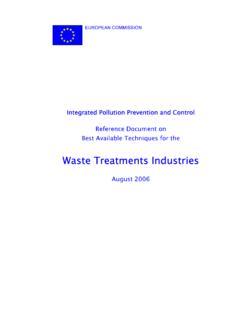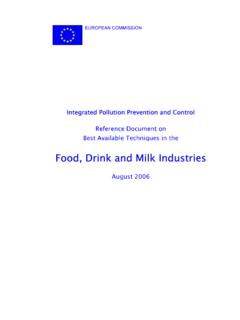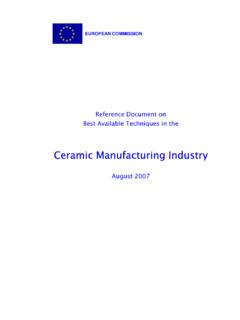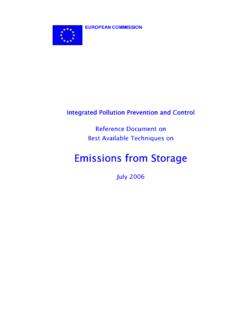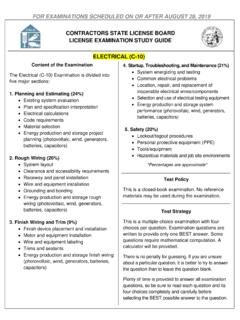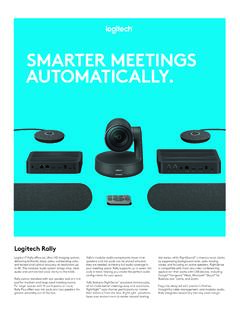Transcription of Surface Treatment of Metals and Plastics - Europa
1 EUROPEAN COMMISSION Integrated Pollution Prevention and Control Reference Document on Best Available Techniques for the Surface Treatment of Metals and Plastics August 2006 This document is one of a series of foreseen documents as below (at the time of writing, not all documents have been drafted): Reference Document on Best Available Techniques .. Code Large Combustion Plants LCP Mineral Oil and Gas Refineries REF Production of Iron and Steel I&S Ferrous Metals Processing Industry FMP Non Ferrous Metals Industries NFM Smitheries and Foundries Industry SF Surface Treatment of Metals and Plastics STM Cement and Lime Manufacturing Industries CL Glass Manufacturing Industry GLS Ceramic Manufacturing Industry CER Large Volume Organic Chemical Industry LVOC Manufacture of Organic Fine Chemicals OFC Production of Polymers POL Chlor Alkali Manufacturing Industry CAK Large Volume Inorganic Chemicals - Ammonia.
2 Acids and Fertilisers Industries LVIC-AAF Large Volume Inorganic Chemicals - Solid and Others industry LVIC-S Production of Speciality Inorganic Chemicals SIC Common Waste Water and Waste Gas Treatment /Management Systems in the Chemical Sector CWW Waste Treatments Industries WT Waste Incineration WI Management of Tailings and Waste-Rock in Mining Activities MTWR Pulp and Paper Industry PP Textiles Industry TXT Tanning of Hides and Skins TAN Slaughterhouses and Animals By-products Industries SA Food, Drink and Milk Industries FDM Intensive Rearing of Poultry and Pigs ILF Surface Treatment Using Organic Solvents STS Industrial Cooling Systems CV Emissions from Storage ESB Reference Document.
3 General Principles of Monitoring MON Economics and Cross-Media Effects ECM Energy Efficiency Techniques ENE Executive Summary Surface Treatment of Metals and Plastics i EXECUTIVE SUMMARY The BAT (Best Available Techniques) Reference Document (BREF) entitled Surface Treatment of Metals and Plastics (STM) reflects an information exchange carried out under Article 16(2) of Council Directive 96/61/EC (IPPC Directive). This executive summary describes the main findings, a summary of the principal BAT conclusions and the associated consumption and emission levels.
4 It should be read in conjunction with the preface, which explains this document s objectives; how it is intended to be used and legal terms. It can be read and understood as a standalone document but, as a summary, it does not present all the complexities of this full document. It is therefore not intended as a substitute for this full document as a tool in BAT decision making. Scope of this document The scope of this document is based on Section of Annex 1 of the IPPC Directive 96/61/EC: Installations for the Surface Treatment of Metals and Plastics using an electrolytic or chemical process where the volume of the Treatment vats exceeds 30 m3.
5 The interpretation of where the volume of the Treatment vats exceeds 30 m3 is important in deciding whether a specific installation requires an IPPC permit. The introduction to Annex I of the Directive is crucial: Where one operator carries out several activities falling under the same subheading in the same installation or on the same site, the capacities of such activities are added together .Many installations operate a mixture of small and large production lines, and a mixture of electrolytic and chemical processes, as well as associated activities.
6 This means that all processes within the scope, irrespective of the scale on which they are carried out, were considered in the information exchange. In practical terms, the electrolytic and chemical processes currently used are water-based. Directly associated activities are also described. The document does not deal with: hardening (with the exception of hydrogen de-embrittlement) other physical Surface treatments such as vapour deposition of Metals hot-dip galvanising and the bulk pickling of iron and steels: these are discussed in the BREF for the ferrous Metals processing industry Surface Treatment processes that are discussed the BREF for Surface Treatment using solvents, although solvent degreasing is referred to in this document as a degreasing option electropainting (electrophoretic painting), which is also discussed in the STS BREF.
7 Surface Treatment of Metals and Plastics (STM) Metals and Plastics are treated to change their Surface properties for: decoration and reflectivity, improved hardness and wear resistance, corrosion prevention and as a base to improve adhesion of other treatments such as painting or photosensitive coatings for printing. Plastics , which are cheaply available and easily moulded or formed, retain their own properties such as insulation and flexibility while the Surface can be given the properties of Metals . Printed circuit boards (PCBs) are a special case where intricate electronic circuits are manufactured using Metals on the Surface of Plastics .
8 STM does not in itself form a distinct vertical sector as it provides a service to a wide range of other industries. PCBs might be considered products but are widely used in manufacturing, for example, computers, mobile phones, white goods, vehicles, etc. Executive Summary ii Surface Treatment of Metals and Plastics The market structure is approximately: automotive 22 %, construction 9 %, food and drink containers 8 %, electrical industry 7 %, electronics 7 %, steel semis (components for other assemblies) 7 %, industrial equipment 5 %, aerospace 5 %, others 30 %.
9 The range of components treated varies from screws, nuts and bolts, jewellery and spectacle frames, components for automotive and other industries to steel rolls up to 32 tonnes and over 2 metres wide for pressing automotive bodies, food and drink containers, etc. The transport of workpieces or substrates varies according to their size, shape and finish specification required: jigs (or racks) for single or small numbers of workpieces and high quality, barrels (drums) for many workpieces with lower quality and continuous substrates (ranging from wires to large steel coils) are processed on a continuous basis.
10 PCBs have particularly complex production sequences. All activities are carried out using jig equipment, therefore the activities are described and discussed for jig plants, with supporting sections describing specific issues for barrel, coil and PBC processing. While no overall figures exist for production, in 2000 the large scale steel coil throughput was about million tonnes and about 640000 tonnes of architectural components were anodised. Another measure of the industry size and importance is that each car contains over 4000 Surface treated components, including body panels, while an Airbus aircraft contains over two million.




